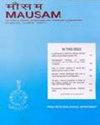高分辨率ROMS-SST对ARW模拟孟加拉湾两个强热带气旋的影响研究
IF 0.7
4区 地球科学
Q4 METEOROLOGY & ATMOSPHERIC SCIENCES
引用次数: 0
摘要
研究了区域海洋模拟系统(ROMS)的高分辨率海表温度(SST)对孟加拉湾(BoB)上形成的两个强涡旋(Phailin和Hudhud)的影响。在BoB上,ROMS-SST与各种观测资料的验证显示出相当好的相关性,大于0.90。均方根差约为0.40°C。将ROMS-SST作为ARW模式的下边界条件,改善了菲律宾TC的强度和降雨位置。TC Hudhud的强度略有改善。尽管如此,与使用全球模型输出的低分辨率Reynolds-SST的控制实验相比,该实验更好地复制了风结构和降雨位置。与对照实验相比,ROMS实验中两种tc的潜热图右扇形峰与红外卫星图像观测到的深对流结构吻合得更好。然而,ROMS-SST实验的模型模拟轨迹并没有改善两种TC在所有初始条件下的轨迹。目前的模式研究对使用中尺度区域海洋模式缩小的更高分辨率海温进行TC模拟进行了补充本文章由计算机程序翻译,如有差异,请以英文原文为准。
Study of the impact of high resolution ROMS-SST on the simulation of two intense tropical cyclones over Bay of Bengal using ARW modeling system
Impact of high-resolution Sea Surface Temperature (SST) derived from the Regional Ocean Modeling System (ROMS) on two intense vortices (Phailin and Hudhud) developed over the Bay of Bengal (BoB) are investigated. The validation of ROMS-SST with various observational datasets available over BoB showed a reasonably good correlation of greater than 0.90. The root mean square difference is around 0.40 °C. Instigating ROMS-SST as a lower boundary condition to the Advanced weather research (ARW) model improved the TC intensity and rainfall location for TC Phailin. A minor improvement is observed in the intensity of TC Hudhud. Still, with better replication of wind structure and rainfall location than the control experiment, which uses low-resolution Reynolds-SST from the global model output. This right sector peak of latent heat pattern matches better with the observed structure of deep convection observed from infrared satellite imagery for both TCs in the ROMS experiment as compared with the control experiment. However, the model simulated track for the ROMS-SST experiment did not improve the TC track for all the initial conditions for both the TCs. The present modeling study compliments the use of higher resolutions SST downscaled by a mesoscale regional ocean model for the TC simulations
求助全文
通过发布文献求助,成功后即可免费获取论文全文。
去求助
来源期刊

MAUSAM
地学-气象与大气科学
CiteScore
1.20
自引率
0.00%
发文量
1298
审稿时长
6-12 weeks
期刊介绍:
MAUSAM (Formerly Indian Journal of Meteorology, Hydrology & Geophysics), established in January 1950, is the quarterly research
journal brought out by the India Meteorological Department (IMD). MAUSAM is a medium for publication of original scientific
research work. MAUSAM is a premier scientific research journal published in this part of the world in the fields of Meteorology,
Hydrology & Geophysics. The four issues appear in January, April, July & October.
 求助内容:
求助内容: 应助结果提醒方式:
应助结果提醒方式:


